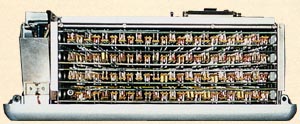
A board of the Programma 101
The electronics
The electronic circuits of the Programma 101 are what makes it interesting, of course.
Designed long before the spread of the integrated circuit, the Programma 101 was completely built with discrete components such as transistors, diodes, resistors and capacitors.

These components are grouped together to form logic ports (i.e. group of components that perform one logic operation such as OR, AND, NOT and so on). Each of these groups of components was assembled together in what was called a "mini-module": a tiny printed circuit board that could be easily tested on its own and whose use would simplyify the design of such a large digital circuit. In this way, one could somehow have the same functionality of an integrated circuit: i.e. modularity in design, top-down approach, and higher mantainability.
In the very same period DEC was applying the same principle to the PDP-8, but the DEC modules are larger boards with higher-level functionalities and with a connector at one side.
The Programma 101 mini-modules were 1 cm wide with lengths varying form 1 cm to about 2.5 cm and they were soldered onto a larger circuit board. They were mounted in lines and the lines were spaced enough to allow two boards with mini-modules to be assembled "face to face" for higher density. 8 such boards make up the brains of the Programma 101, with a total of about 900 mini-modules and about 6.000 components.

This very strictly packed block of electronics is enclosed in a tight metal box, with a fan providing enough air circulation to keep the temperature from rising too much.